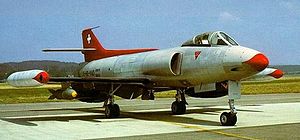FFA P-16 Video - Picture

|
|
FFA P-16

Picture - FFA P-16 composite on display at the Swiss Air Force Museum Dx¼bendorf
Role: Fighter
Manufacturer: FFA
Designed by: Dr. Hans Studer
First flight: 25 April 1955
Retired: Cancelled
Number built: 5
The FFA P-16 was a Swiss prototype ground attack jet fighter designed in the 1950s to replace the piston-engined types then in service with the Swiss Air Force. It was Switzerland's second attempt to develop a domestically-designed and manufactured jet fighter, but the project was terminated before it could be introduced into service.
Design and development
The P-16 was designed to be especially well-suited to the close-support role, and short-field performance was also emphasized. The resulting aircraft was a single-seat, single-engine design with intakes on the fuselage sides and a low wing. The horizontal stabilizer was mounted half-way up the fin. To ensure good performance from unprepared fields, heavy undercarriage and dual wheels and tires were fitted. The wing was the most remarkable part of the design due to its high-lift devices; slats along the entire leading edge, large Fowler-type flaps along the trailing edge, and ailerons which also operated as flaps. These devices allowed the aircraft to take off and land within 1,000 ft (330 m).
Testing and evaluation
Two prototypes were ordered in 1952, the first one flying on 25 April 1955. Although this aircraft was destroyed in a crash only four months later (12.5 hours flight time), a development contract for four pre-production aircraft was awarded. On 15 August 1956, the second prototype exceeded the sound barrier for the first time.
The pre-production machines (designated Mk II) differed from the prototypes in a variety of ways, but most especially in the fitting of a more powerful Sapphire 7 engine, in place of the prototype's Sapphire 6.
When test flights proved promising, a new contract was awarded in 1958 for 100 aircraft. When the first pre-production machine was destroyed in another crash, the government cancelled the entire order and bought Hawker Hunters from the UK instead.
FFA continued the program at its own expense for a while, completing two more aircraft, but was unable to attract buyers. Certain design concepts of the P-16, such as the multi-spar wing structure, were used by Bill Lear when developing the first of the highly successful Learjet family of business jets. The Learjet was a new design, however, and was not developed from the P-16 as is sometimes claimed. As of 2007, only a single example, assembled from parts of two of the prototypes, remains in existence. It is on display at the Swiss Air Force Museum at the Dx¼bendorf airbase.
Variants
Mk I - two prototypes with Sapphire 6 engine
Mk II - pre-production machine with Sapphire 7 engine. Only one built out of an order of four before the project was cancelled.
Mk III - two further examples built privately by FFA in an attempt to revive project
Proposed variants to be built by AFU
AA-7 - SNECMA Atar 9C engine
AJ-7 - General Electric J79 engine
AR-7 - Rolls-Royce RB.168 engine
Specifications (Mark III)
Data from Switzerland's P-16:Father of the Learjet
General characteristics
Crew: one pilot
Length: 14.33 m (47 ft)
Wingspan: 11.15 m (36 ft 7 in)
Height: 4.27 m (14 ft 0 in)
Wing area: 30.0 m² (323 ft²)
Empty weight: 7,037 kg (15,500 lb)
Max takeoff weight: 11,713 kg (25,800 lb)
Powerplant: 1 x— Armstrong Siddeley Sapphire ASSa.7 turbojet, 49.1 kN (11,000 lbf)
Performance
Maximum speed: 1,118 km/h (604 knots, 694 mph) at sea level, clean
Stall speed: 179 km/h (97 knots, 111 mph)
Range: 1,447 km (781 nmi, 899 mi) at 9,150 m (30,000 ft)
Service ceiling: 14,000 m (46,000 ft)
Rate of climb: 65.0 m/s (12,795 ft/min)
Armament
Guns: 2 x— 30 mm Hispano-Suiza HS 825 cannon in nose with 120 rpg
Hardpoints: 4 with a capacity of Up to 2,590 kg (5,700 lb) of external stores
Rockets: 44 & times; 68 mm Matra FFAR in retractable launcher under fuselage
Bibliography
Green, William and Gerald Pollinger.Die Flugzeuge der Welt (in German). Zurich, Switzerland: Werner Classen Verlag, 1960.
Frickler, John. "Switzerland's P-16: Father of the Learjet." Air International, March 1991, Vol. 40, No. 3. pp. 139-146.
Johnson, Robert Craig. "Swiss Guards: the Federal Aircraft Factory N-20 and the FFA P-16." Chandelle 2 (2), 1997.
Schx¼rmann, Roman. Helvetische Jx¤ger. Dramen und Skandale am Militx¤rhimmel(in German). Zurich: Rotpunktverlag, 2009. ISBN 978-3-85869-406-5.
Strehler, Hanspeter. Das schweizer Dx¼senflugzeug P-16 (in German). Erschienen, Switzerland: 2004. ISBN 3-03-300051-7.
Taylor, Michael J.H. Jane's Encyclopedia of Aviation. London: Studio Editions, 1989. pp. 39, 383. ISBN 0-51710-316-8.
FFA P-16 Pictures
More airplane videos.
Source: WikiPedia